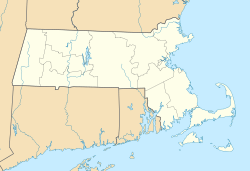Newspaper Row (Boston) facts for kids
Quick facts for kids |
|
|
Newspaper Row
|
|
 |
|
| Location | Boston, Massachusetts |
|---|---|
| Built | 1873 |
| Architect | Multiple |
| Architectural style | Late Victorian |
| NRHP reference No. | 83000607 |
| Added to NRHP | July 7, 1983 |
Newspaper Row is a special historic district in Boston, Massachusetts. It includes buildings on Washington Street, Milk Street, and Hawley Street.
For many years, from the late 1800s to the early 1940s, this area was the heart of Boston's newspaper world. It was a very important place for news and information.
Contents
What Was Newspaper Row?
Imagine a time before radio, TV, or the internet. How did people get the news quickly? In Boston, they went to Newspaper Row! This area was filled with offices of many major newspapers.
Newspaper Row stretched from Milk Street down to the Old State House. It was a busy and exciting place.
How News Spread Back Then
Newspapers didn't just print the news in their papers. They also shared it in a very public way. Outside their offices, they had big blackboards and bulletin boards.
When important news came in, like election results or sports scores, staff members would quickly write it on these boards. Crowds would gather, eager to get the very latest updates. Sometimes, they even used megaphones to shout out the news!
A Busy Gathering Place
Newspaper Row was more than just a place to get headlines. It became a popular spot for people to meet and talk. Reporters, politicians, lawyers, and everyday citizens would mix and share ideas.
It was a noisy and crowded part of downtown Boston. But people who worked there loved the energy. Everyone was swapping stories and getting the inside scoop.
Fun Events and Important Causes
Newspaper Row was also used for special events and to support different causes. Because so many people stopped by, it was a great place to get attention.
For example, in 1909, people who wanted women to have the right to vote (called suffrage) sold their newspapers there. They talked to the crowds about why voting was important for women.
Another fun event happened in 1914. The Boston Post newspaper helped raise money to buy three new elephants for the Franklin Park Zoo. They even held a parade on Newspaper Row! Thousands of kids came to see the elephants up close.
Why Newspaper Row Changed
Over time, new ways of getting news appeared. People started listening to the radio for updates. They no longer needed to wait on Washington Street for the latest headlines.
Slowly, the big crowds on Newspaper Row became smaller. Many newspapers either closed down or moved to bigger buildings. The last newspaper to leave Newspaper Row was the Boston Globe, in 1958.
Remembering Newspaper Row
Even though the newspapers are gone, Newspaper Row is still an important part of Boston's history. In 1983, it was added to the National Register of Historic Places. This means it's recognized as a special historical site.
In 2003, the Bostonian Society placed a historical marker at 244 Washington Street. This was once the home of the Boston Globe, reminding everyone of the area's rich past.
Image gallery








